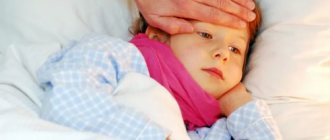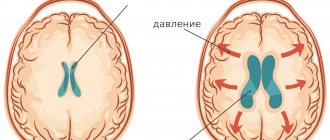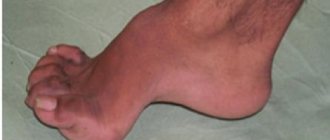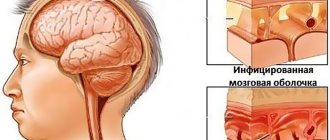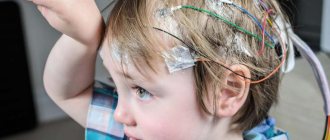Meningitis in children is an acute infectious disease in which inflammation of the membranes of the brain and spinal cord develops. Children's meningitis is severe. If antimicrobial therapy is not started in a timely manner or is inadequate, severe complications develop in children with meningitis. The Yusupov Hospital has all the conditions for the treatment of meningitis:
- the wards are equipped with forced-air ventilation and air conditioning;
- patients are provided with individual personal hygiene products and dietary nutrition;
- Patients are examined using devices from leading global manufacturers and modern laboratory diagnostic methods;
- Doctors use the latest generation antibacterial and antiviral drugs, which are highly effective and have minimal side effects.
Severe cases of meningitis are discussed at a meeting of the expert council with the participation of candidates and doctors of medical sciences. Leading specialists in the field of treatment of infectious diseases of the central nervous system make a collegial decision regarding the management of patients with severe meningitis. The clinic accepts patients aged 18+.
Causes of meningitis in children
Children's meningitis can be primary (develop without previous signs of a pathological process caused by the corresponding pathogen) or secondary, when damage to the meninges is preceded by other manifestations of infection (mumps, measles, leptospirosis).
The following microorganisms can cause meningitis:
- bacteria (pneumococcus, meningococcus, Haemophilus influenzae and tuberculosis bacilli, spirochetes);
- viruses (enteroviruses of the Coxsackie-ECHO group, mumps and measles virus);
- chlamydia;
- mycoplasma;
- protozoa;
- mushrooms.
Meningitis most often affects children who belong to the following risk groups:
- premature;
- those born with intrauterine fetal hypoxia or as a result of difficult labor;
- with congenital or acquired immunodeficiency;
- who have undergone craniocerebral, spinal, vertebral trauma, neurosurgical operations and surgical interventions on the abdominal organs.
Children under 5 years of age are more likely to get meningitis. The risk of getting meningitis increases in children who attend preschool institutions and schoolchildren. Children who do not follow the rules of personal hygiene, swallow contaminated water when swimming in reservoirs, and eat food contaminated with rodent excrement are more likely to get sick. The causative agents of meningitis are transmitted by ixodid ticks.
There is a high risk of developing meningitis in children who have not been vaccinated against mumps, measles and rubella, or who have missed vaccinations with Haemophilus influenzae, meningococcus, or pneumococcal conjugate vaccines. When traveling to places dangerous for meningitis, children must be vaccinated no later than 2 weeks before the child’s departure.
The source of pathogens of childhood meningitis are sick people or bacteria carriers. Infectious agents can be transmitted by airborne droplets (with dust and saliva particles), contact (through dirty hands), waterborne, transmissible (through insect bites) and fecal-oral mechanisms. The entry points for infection are the mucous membranes of the upper respiratory tract and digestive organs. The causative agents of meningitis spread throughout the body in the following ways:
- hematogenous (through blood vessels);
- lymphogenous (lymph flow);
- geirogenic (with cerebrospinal fluid).
Meningitis in children is accompanied by the following pathological changes:
- increased production of cerebrospinal fluid;
- increased intracranial pressure and permeability of the blood-brain barrier;
- toxic damage to the brain substance;
- disorders of cerebral circulation, especially microcirculation;
- liquorodynamic disorder;
- hypoxia (insufficient oxygen supply) of the brain.
Eventually, swelling of the brain tissue develops. This is facilitated by the spread of the inflammatory process to the ventricles and brain matter, which is characteristic of purulent meningitis. With viral meningitis, cerebral edema is less pronounced, but the medulla is also involved in the pathological process. When the inflammatory process spreads to the brain, focal neurological symptoms appear.
Edema and swelling of the brain leads to its displacement with compression of the brain stem by the cerebellar tonsils. At the same time, the function of vital organs, especially breathing, is disrupted in children, which can lead to death. After suffering viral meningitis, most children do not develop complications. Children who have had bacterial meningitis may be retarded in mental development, and they sometimes develop impaired vision and hearing to the point of complete deafness.
How can you get infected?
If you are interested in how you can become infected with meningitis, then first you should know about the way the infection multiplies. The methods of its reproduction are different, but the most common are:
- Airborne (the patient may sneeze and cough).
- Contact and household (personal hygiene rules are not followed).
- Oral-fecal (eating unwashed foods or eating with unwashed hands).
- Hematogenous (infection occurs through blood).
- Lymphogenic (infection through lymph).
- Placental (at the time of pregnancy and birth of a child from mother to her fetus).
- If a person bathes in dirty water, the infection enters the body.
The incubation period for this disease ranges from 2 to 4 days, this period from infection to the first signs. But sometimes it lasts a couple of hours or, on the contrary, it takes up to 20 hours. It is also important to consider that the disease can be primary and secondary. The first option is an independent disease. The second is a consequence of the fact that there is already an infection in the body, for example, a person suffers from influenza, otitis media, tuberculosis.
meningitis symptoms
If it is serous meningitis, then it is considered contagious. If the disease is secondary, then other people will not become infected with it.
Symptoms of meningitis in children
The clinical picture of meningitis in children depends on the type of pathogen. In all cases of childhood meningitis, general symptoms predominate, which are united by the concept of “meningeal” syndrome. Meningitis in children often begins acutely rather than gradually. Typically, the symptoms of meningitis are preceded by general signs of an infectious disease: fever, weakness, pain in the joints and muscles. With meningococcal infection, hemorrhagic rashes appear in children, with pneumococcal infection - signs of rhinitis, pneumonia, otitis, with mumps - damage to the salivary glands, with enterovirus infection - dyspeptic disorders and catarrhal phenomena.
Meningeal syndrome has the following symptoms:
- rigidity or stiffness of the neck muscles due to a pathological increase in their tone;
- Kernig's symptom - the patient is unable to fully straighten a previously bent leg at a right angle at the knee and hip joints;
- Brudzinski's symptom: upper - when the patient tilts his head to the chin and lies on his back, the lower limbs automatically bend, lower - if the patient bends one leg at the knee joint, the second limb bends automatically;
- hyperesthesia – increased sensitivity to painful, auditory, olfactory and tactile stimuli, intolerance to bright light;
- local complete or partial paralysis.
Children develop the following signs of meningitis:
- Lesage's symptom - when the baby is taken by the armpits, he presses his legs to his tummy, which cannot be straightened (typical for children under one year old);
- “tripod” symptom – a child, sitting on a flat surface with his legs extended forward, bends his legs or leans back;
- bulging fontanelle;
- Filatov's symptom - when the baby tilts his head quickly or sharply, his pupils dilate.
In children under three years of age, it is extremely rare to have all the signs of meningeal syndrome. Symptoms of meningitis in children 7-8 years old do not differ from signs of the disease in adults. The temperature during meningitis in children rises to 41-42o. Children are bothered by a severe headache that spreads throughout the head. They cry, sometimes screaming.
From the first days of the disease, small dark cherry pinpoint rashes appear on the child’s body. In the presence of severe meningococcal infection, the elements of the hemorrhagic rash merge, and large spots or bruises may appear. The child's consciousness is impaired, convulsions and epileptic seizures develop. Children are worried about nausea, continuous vomiting, not associated with food intake, which does not bring relief.
Why do spots appear?
The appearance of spots on a child's skin is a very dangerous symptom of meningitis .
This phenomenon is called meningeal rash, and, as a rule, begins from the legs, gradually rising higher and higher. The main reason for the appearance of spots lies in the harmful effects of meningococci on the child’s body. As a rule, the appearance of a rash is characteristic of purulent meningitis, so it is necessary to begin treatment urgently, otherwise the consequences can be very dire.
Diagnosis of meningitis in children
Decisive for confirming the diagnosis of meningitis in children is the examination of cerebrospinal fluid. It is obtained by lumbar puncture. According to indications, children undergo additional studies:
- radiography of the skull and paranasal sinuses;
- fundus examination;
- electroencephalography;
- echo-encephalography;
- computer and nuclear magnetic resonance tomography.
During a spinal puncture, the pressure of the cerebrospinal fluid, the visual characteristics of the cerebrospinal fluid (color, transparency) are determined, and the cerebrospinal fluid dynamic tests of Stuckey and Queckenstedt are performed. In the liquid sediment, the number and composition of cells and the presence of microorganisms are determined. Biochemical (glucose, protein, chloride content, sediment samples) and microbiological studies are carried out.
With meningococcal meningitis in children, the cerebrospinal fluid is cloudy, yellowish or milky white. One milliliter of cerebrospinal fluid contains several thousand neutrophils. Characteristic bean-shaped diplococci are often visible in their cytoplasm. When sowing, a culture of the pathogen is isolated. An increased amount of protein and a decreased level of glucose are detected in the cerebrospinal fluid. Using immunological methods, the pathogen's antigen is detected in the cerebrospinal fluid, and its DNA is detected using the polymerase chain reaction. Signs of a pronounced inflammatory process are detected in the blood.
With pneumococcal meningitis in children, meningeal syndrome is detected somewhat later than with meningococcal infection. Even if the child is hospitalized early, the disease progresses rapidly. Disorders of consciousness, convulsions, and often paresis of cranial nerves or partial paralysis of half the body appear early. The cerebrospinal fluid is purulent. In it, under a microscope, extracellularly located lanceolate-shaped diplococci are visible.
Meningitis caused by Haemophilus influenzae is most often observed in children under one year of age. The disease can begin either acutely or gradually. Meningeal symptoms appear on days 2–5 of illness. In children under one year of age, the most serious signs of meningitis are regurgitation or vomiting, bulging and cessation of pulsation of the fontanel, and an unmotivated high-pitched cry.
Viral meningitis is preceded by a clinical picture characteristic of the corresponding infection. Symptoms of meningitis appear later. With viral meningitis, body temperature rises to moderate numbers, meningeal symptoms appear on the 2-3 or 5-7 seventh day from the onset of the disease. Children are bothered by an intense headache, which goes away after a diagnostic lumbar puncture and evacuation of a small amount of cerebrospinal fluid.
Does it happen without fever?
It should be noted that often not always a child may experience a full set of symptoms characteristic of meningitis . In particular, an increase in body temperature is not necessary. It may remain at the same level.
IMPORTANT : However, in any case, at the slightest suspicion that a child has this disease, it is necessary to urgently contact a medical institution, since sometimes the count may not be days, but hours.
You should especially carefully monitor the condition of infants, since they cannot express in words what exactly is bothering them.
Prevention of IUI
It is very important for a woman planning a pregnancy to take all possible measures to exclude the possibility of congenital infections in the newborn. First of all, you need to register with a gynecologist within 12 weeks. It is necessary to listen to the recommendations of specialists and conduct a full examination of the health of the expectant mother, including the following tests:
- flora smear;
- PCR test for the presence of chlamydia, mycoplasma, ureaplasma, herpes simplex virus, cytomegalovirus;
- serological blood test for toxoplasmosis, rubella, HIV, hepatitis and other infections.
It is also necessary to treat existing chronic foci of infection (caries, tonsillitis, genitourinary infectious diseases) and not forget about routine vaccination - vaccinations against measles, rubella, and influenza.
In addition, in order to exclude sexually transmitted infections, it is advisable to have your sexual partner examined, and of course, to avoid casual sexual relations.
“I wish you to give birth to a living, healthy child. So that further in life he only pleases you with his successes, first in his studies, and then further in his work. And for this we must, firstly, be ready and, secondly, we must be fully examined. That is, a woman who decides to become a mother must a priori be healthy.”
Ulukhanova Lala Udzhagovna, Doctor of Medical Sciences, professor, pediatrician, gastroenterologist, infectious disease specialist, nephrologist, pulmonologist in Makhachkala, specialist of the highest qualification category.
What will a fetal ultrasound show?
Ultrasound examination (ultrasound) of the fetus during gestation helps the specialist to timely detect the presence of various pathologies in the development of the unborn child. These are, for example, oligohydramnios or polyhydramnios, a large belly, enlarged internal organs, for example, the liver, spleen. Ultrasound diagnostics can also detect calcification deposits in the intestines, liver, and brain. In our medical diagnostic and treatment center in Makhachkala, experienced ultrasound diagnostic specialists will conduct a high-quality study that will confirm or exclude pathology with high reliability.
The ultrasound markers of intrauterine infection discovered during the study are a real help in assessing the condition of the fetus and predicting further pregnancy management tactics. If possible, doctors will take measures at an early stage to eliminate any detected abnormalities. If this is a condition that is incompatible with life, then a decision is made that it is better to terminate the pregnancy.
We diagnose at home
The main task of parents is to promptly recognize the appearance of meningitis in a child 1-2 years old by signs and symptoms and seek qualified help from a medical institution.
We recommend using the step-by-step steps below.
Take the baby's temperature: with meningitis it is high and is accompanied by the child's lethargy and weakness.- Pay attention to the baby’s consciousness: when inflammation of the meninges develops, it is confused, and he does not make contact with an adult.
- See if there is any strange position of the baby's body. Meningitis is characterized by a peculiar position when he lies on his side for a long time, bending his knees and pressing them to his body, while his head is thrown back.
- If convulsions occur , they may indicate a serious condition.
Important! Don't wait for your child to get worse. At the slightest suspicion of the development of meningitis, consult a specialist immediately!
Differences from ARVI
Serous and meningococcal forms at an early stage often resemble colds. They are accompanied by elevated body temperature and the appearance of weakness, as with ARVI.
However, parents should be wary if the disease develops rapidly. The baby is capricious and refuses to eat. Loud noises and bright lights irritate him.
When a child has a cold, he takes a characteristic position : on his side in a lying position, he brings his legs to his stomach and throws his head back. Any change in posture is accompanied by the appearance of wild pain.
To confirm the diagnosis, the doctor performs tests to confirm inflammation of the meninges. The most common test for neck stiffness is that the doctor places one hand on the upper chest and the other on the back of the baby's head. Then the specialist presses on the back of the head, bending the neck, and the chin reaches the palm that lies on the chest. If a baby develops meningitis, such a test cannot be performed.
Providing first aid to a child
The first thing the baby’s parents must do is call an ambulance. There is no need to put off calling, much less try to treat your child on your own!
Remember: the faster quality, qualified assistance is provided, the greater the child’s chances of recovery.
Before the arrival of specialists, it is necessary to provide the little patient with peace, silence and darkness. You should not let your child get up.
If he needs to go to the toilet, provide a bedpan or put on a diaper. The baby should be given drinks more often. If vomiting occurs, it is necessary to turn the child's head to the side to prevent vomit from entering the respiratory tract.
The same technique should be carried out in the case when a small patient experiences convulsions. This will protect the baby during an attack from the tongue retracting and blocking the respiratory tract.

